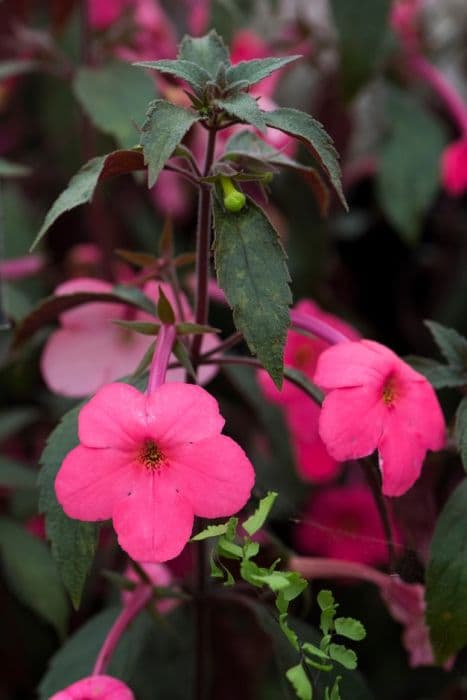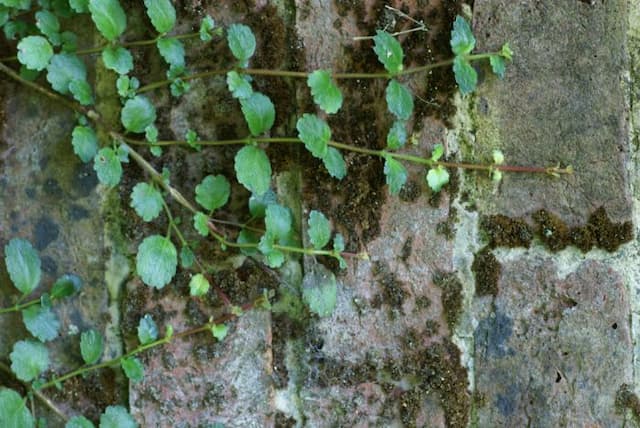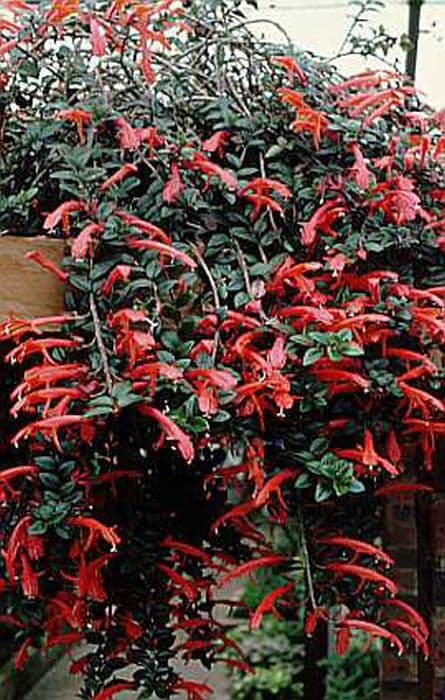Hairy Kohleria Kohleria hirsuta

ABOUT
Kohleria hirsuta, also known as the Hairy Kohleria, is a striking plant with an appearance that catches the eye due to its distinct features. It is adorned with lush, green foliage that forms the backdrop for its vibrant flowers. The leaves of the Hairy Kohleria are soft, with a velvety texture and are covered in fine hairs that give the plant a somewhat fuzzy appearance, which is particularly noticeable when touched or under light. The flowers of the Hairy Kohleria are its most remarkable feature. They typically emerge in shades of red, orange, or pink, with a tubular shape that flares out into a wider mouth, resembling a trumpet or a bell. These blooms may have intricate patterns within, including speckles or streaks of contrasting colors, which add to their ornamental appeal. The flowers stand out against the foliage, creating an attractive display with their bright, warm colors that can draw the attention of any passerby. In short, the Hairy Kohleria is a plant that boasts soft, furry leaves and produces eye-catching, trumpet-shaped flowers that come in a variety of warm colors, making it a favored choice for those who appreciate unique and decorative houseplants.
About this plant
 Names
NamesSynonyms
Hairy Kohleria, Red Ryder Kohleria.
Common names
Kohleria hirsuta.
 Toxicity
ToxicityTo humans
Kohleria hirsuta is not commonly known to be toxic to humans. There is no widely documented evidence to suggest that this plant, often referred to by its genus name, Kohleria, is poisonous upon ingestion or contact. However, even with non-toxic plants, individual allergies or sensitivities can occur, so it's always advisable to exercise caution and prevent ingestion of any houseplants to avoid potential adverse reactions.
To pets
Kohleria hirsuta, simply known as Kohleria, is not specifically listed as toxic to pets by major pet poison control resources. Generally, ingestion of non-toxic plant material can sometimes cause mild gastrointestinal upset in pets due to the fiber content or if the pet has a sensitivity to the plant. If you suspect your pet has ingested Kohleria, and they are showing signs of distress, it's best to consult a veterinarian.
 Characteristics
CharacteristicsLife cycle
Perennials
Foliage type
Deciduous
Color of leaves
Green
Flower color
Red
Height
1-2 feet (30-60 cm)
Spread
1 foot (30 cm)
Plant type
Herb
Hardiness zones
10
Native area
Central America
Benefits
 General Benefits
General Benefits- Aesthetic Appeal: Kohleria hirsuta, commonly known as Hairy Kohleria, adds a touch of tropical beauty to homes and gardens with its lush foliage and striking flowers.
- Humidity Tolerance: Hairy Kohleria is well-adapted to high humidity environments, making it a suitable plant for terrariums and bathrooms.
- Ease of Propagation: Hairy Kohleria can be easily propagated through leaf cuttings or division, allowing gardeners to create new plants without much effort.
- Seasonal Interest: The plant typically blooms in cycles, providing seasonal interest throughout the year with its vibrant flowers.
- Pollinator Attraction: When grown outdoors, the colorful flowers of Hairy Kohleria can attract butterflies and hummingbirds, contributing to local biodiversity.
 Medical Properties
Medical PropertiesThis plant is not used for medical purposes.
 Air-purifying Qualities
Air-purifying QualitiesThis plant is not specifically known for air purifying qualities.
 Other Uses
Other Uses- Kohleria hirsuta, commonly known as the Hairy Kohleria, can sometimes be used in botanical illustrations and educational materials due to its unique appearance and structure, providing visual interest and learning opportunities.
- The plant's vibrant flowers can be a source of natural dye for textiles and artwork, offering a palette of pink and violet hues.
- In horticulture, the Hairy Kohleria is used as a parent in hybridization processes to create new ornamental varieties with diverse characteristics.
- Due to its texture and unique aesthetics, the Hairy Kohleria is occasionally employed in set and stage design to provide an exotic or tropical ambiance.
- Its leaves and blooms can be used in the craft industry for making floral arrangements, wreaths, and other decorative items.
- The Hairy Kohleria is sometimes used as a living teaching tool in classrooms or workshops focussing on botany and horticulture.
- Enthusiasts of the plant might cultivate collections of Kohleria hirsuta as a hobby, which could be showcased in plant exhibitions and competitions.
- In photography, the unique shape and colors of the Hairy Kohleria can make it an intriguing subject for macro and close-up photography enthusiasts.
- As a candidate for micropropagation research, the Hairy Kohleria can be of interest to scientific studies examining the propagation techniques of ornamental plants.
- The long-lasting nature of its bloom can make the Hairy Kohleria a suitable candidate for use in temporary indoor plant displays or living installations in public spaces and events.
Interesting Facts
 Feng Shui
Feng ShuiThe Kohleria is not used in Feng Shui practice.
 Zodiac Sign Compitability
Zodiac Sign CompitabilityThe Kohleria is not used in astrology practice.
 Plant Symbolism
Plant Symbolism- Unique Beauty: Kohleria hirsuta, commonly known as Velvet Plant or Fuzzy Koleria, has distinctive hairy leaves and striking flowers, symbolizing the beauty of uniqueness and the charm of standing out.
- Resilience: The ability of this plant to thrive under various conditions is often symbolic of resilience and adaptability in the face of challenges.
- Warmth: The vibrant blooms of the Velvet Plant can symbolize warmth and positivity, much like its warm-growing environment suggests.
- Attention to Detail: The intricate patterns and soft texture of the blooms and leaves can represent a love for detail and intricacy in one's life.
 Water
WaterFor the Velvet-Leaf Kohleria, watering should be consistent, keeping the soil slightly moist but not soggy. They typically require watering once every 5 to 7 days, but this can vary depending on the warmth and humidity of their environment. Water the Velvet-Leaf Kohleria with about 10-12 ounces of water, or enough to moisten the soil throughout the pot. It's important not to let the plant sit in water, so ensure proper drainage. During the winter months when the plant is not actively growing, water less frequently, allowing the top inch of soil to dry out between waterings.
 Light
LightThe Velvet-Leaf Kohleria thrives in bright, indirect sunlight. A north-facing or east-facing window that provides plenty of light without direct sun is ideal, as intense direct sunlight can scorch the leaves. They can also do well under fluorescent lights, making them suitable for office spaces or rooms without ample natural light.
 Temperature
TemperatureVelvet-Leaf Kohleria prefers warm conditions and doesn’t tolerate cold well. The ideal temperature for growth is between 65°F and 75°F. It’s important to keep the plant away from drafts and sudden temperature changes, and they should not be exposed to temperatures below 50°F, as this can damage the plant.
 Pruning
PruningPruning Velvet-Leaf Kohleria helps maintain its shape and encourages bushier growth. It is best to prune in spring just before the growth season begins. Remove any leggy or dead stems, as well as spent flowers to promote new growth. Pruning can be done every few months to keep the plant looking its best.
 Cleaning
CleaningAs needed
 Soil
SoilThe best soil mix for Kohleria, commonly known as Teddy Bear Vine, should be well-draining and rich in organic matter, such as a mix of peat, perlite, and fine bark. Aim for a slightly acidic to neutral soil pH of 6.0 to 7.0.
 Repotting
RepottingTeddy Bear Vine should be repotted every 1-2 years or when it outgrows its pot, using fresh soil mix to replenish nutrients and encourage healthy growth.
 Humidity & Misting
Humidity & MistingTeddy Bear Vine thrives in high humidity levels, ideally between 60-80%. Maintain consistent humidity for optimal growth and flowering.
 Suitable locations
Suitable locationsIndoor
Place Teddy Bear Vine in bright, indirect light indoors.
Outdoor
Grow Teddy Bear Vine in shade and shelter outdoor.
Hardiness zone
10-11 USDA
 Life cycle
Life cycleKohleria hirsuta, commonly known as Hairy Kohleria, begins its life cycle as seeds, which require warm, moist conditions to germinate. Upon germination, seedlings develop into young plants with characteristic fuzzy leaves, a stage during which consistent moisture and warmth are crucial for healthy growth. As the plant matures, it enters the vegetative stage, producing more leaves and stems, and eventually forms buds that will bloom into vibrant tube-like flowers. After pollination, which is often facilitated by hummingbirds or insects, the flowers will produce tiny seeds, completing the reproductive cycle. If conditions are not suitable for seeding, Hairy Kohleria can also propagate vegetatively through rhizomes or cuttings. During the dormant stage, often in response to cooler temperatures or shorter day lengths, the above-ground parts of the plant may die back, with the rhizomes resting until favorable growth conditions return.
 Propogation
PropogationPropogation time
Spring to Summer
Kohleria hirsuta, commonly known as the Hairy Kohleria, is typically propagated from rhizomes, which is the most popular method. This process is best done in the spring when the plant is coming out of dormancy and starting to show active growth. To propagate, a gardener would carefully unearth the rhizome, making sure to retain as many roots as possible, and then cut it into sections, each with one or two growth points, known as 'eyes'. These sections should then be planted in a well-draining soil mix, covering them with about 1 inch (2.54 centimeters) of soil. The newly planted rhizomes should be kept moist and in indirect light until new growth indicates they have established. Once active growth is visible, the young plants can be cared for in the same manner as mature Hairy Kohleria.









